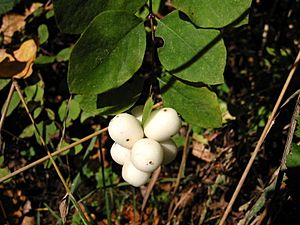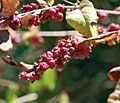Symphoricarpos facts for kids
Quick facts for kids Symphoricarpos |
|
|---|---|
 |
|
| Common snowberry (S. albus) | |
| Scientific classification |
|
| Kingdom: | Plantae |
| Clade: | Tracheophytes |
| Clade: | Angiosperms |
| Clade: | Eudicots |
| Clade: | Asterids |
| Order: | Dipsacales |
| Family: | Caprifoliaceae |
| Subfamily: | Caprifolioideae |
| Genus: | Symphoricarpos Duhamel 1755 |
| Synonyms | |
|
|
Symphoricarpos, often called snowberry, waxberry, or ghostberry, is a group of small shrubs. There are about 15 different kinds, and they belong to the honeysuckle family, called Caprifoliaceae. Most snowberry plants grow naturally in North America and Central America. Only one type, the Chinese coralberry (S. sinensis), comes from western China.
The name Symphoricarpos comes from ancient Greek words. "Symphorein" means "to bear together," and "karpos" means "fruit." This name describes how the berries grow in tight clusters on the plant. Snowberry plants are very tough. They can grow in many different places. You can often find them in forests, on rocky hillsides, or near rivers and streams. They can also grow in various types of soil, from sandy to clay. These plants can handle different soil acidity levels (pH) and sunlight conditions too.
Contents
What Does Snowberry Look Like?
Snowberry leaves are usually about 1.5 to 5 centimeters (0.6 to 2 inches) long. They are rounded, and some might have one or two small bumps at the bottom. The flowers are tiny, often greenish-white to pink. They grow in small groups of 5 to 15 flowers. Some types, like S. microphyllus, have flowers that grow alone or in pairs.
The fruits are the most noticeable part. They are round, about 1 to 2 centimeters (0.4 to 0.8 inches) wide, and soft. Snowberries can be white (like S. albus), pink (like S. microphyllus), or red (like S. orbiculatus). One type, S. sinensis, has blackish-purple berries. If you break open a white berry, the inside looks like sparkling, fine snow. The fruit is spongy and holds two hard, whitish seeds. These seeds are tough to grow because they have a very hard coating. They can stay dormant for up to ten years before sprouting.
When you step on white snowberries on firm ground, they make a fun cracking sound!
Important Safety Note: The berries of the common snowberry (S. albus) are considered poisonous to humans. If children eat them, it can cause mild problems like throwing up, feeling dizzy, or feeling a little sleepy. It's best not to touch or eat them.
Types of Snowberry Plants
Here are some of the different kinds of snowberry plants:
- Symphoricarpos acutus – Sharpleaf snowberry: Found in California, Nevada, Oregon
- Symphoricarpos albus – Common snowberry: Found across Canada and the USA
- Symphoricarpos × chenaultii – Chenault coralberry
- Symphoricarpos × doorenbosii
- Symphoricarpos guadalupensis – McKittrick's snowberry: Found in western Texas
- Symphoricarpos guatemalensis: Found in Guatemala
- Symphoricarpos hesperius – Trailing snowberry: Found in California, Baja California, Oregon, Washington, British Columbia
- Symphoricarpos longiflorus – Desert snowberry: Found in the southwestern USA and northwestern Mexico
- Symphoricarpos microphyllus – Littleleaf snowberry: Found in Mexico, Guatemala, New Mexico
- Symphoricarpos mollis – Creeping snowberry: Found in California
- Symphoricarpos occidentalis – Western snowberry, Wolfberry: Found in the USA and Canada
- Symphoricarpos orbiculatus – Coralberry: Found in northeastern Mexico, eastern and central USA
- Symphoricarpos oreophilus – Mountain snowberry: Found in northern Mexico, western USA, western Canada
- Symphoricarpos palmeri – Palmer's snowberry: Found in Mexico, southwestern USA
- Symphoricarpos parishii: Found in California, Nevada, Baja California
- Symphoricarpos rotundifolius – Round-leaved snowberry: Found in Mexico, southwestern USA
- Symphoricarpos sinensis – Chinese snowberry: Found in China
- Symphoricarpos vaccinioides – Roundleaf snowberry: Found in California
How Snowberry Plants Reproduce
Snowberry plants are hermaphroditic. This means each plant has both male and female parts for reproduction. They can grow from seeds, but they usually reproduce by sending out new shoots from an underground stem called a rhizome. This way, snowberry plants can grow in thick groups of bushes and trees.
Snowberry plants also use a method called layering. This is when their vertical stems bend down and touch the soil. Once a stem touches the ground, it starts to grow new roots. This helps the plant spread even more. Snowberry plants are very strong. Studies show they can even survive seasonal fires. In fact, these fires can help the plants reproduce more. After a fire, new plants grow, which means more stems are available for layering to happen.
Common snowberry (S. albus) is an important winter food for some birds, like quail, pheasant, and grouse.
Growing Snowberry and Its Uses
Common snowberry is a popular plant to grow in gardens. People like it for its pretty white berries and because it helps attract wildlife. It's also a great plant for landscaping because it's so adaptable. It can handle lots of sun, shade, heat, cold, dry spells, and even floods.
Native American tribes used snowberry for many medicinal purposes. Snowberry contains small amounts of natural compounds called saponins. These saponins can help fight cancer and reduce swelling. They also help your immune system and can lower cholesterol. While large amounts of saponins can be harmful, they were usually used externally or in very small, safe amounts.
The snowberry plant was known to help clean wounds, act as a mild laxative, help the body get rid of extra water (diuretic), and reduce fever. Native Americans found many ways to use this plant:
- Leaves: They would chew the leaves and use them as a poultice (a soft, moist mass) on outside wounds.
- Berries: The berries were used for eye washes, to stop sweating, and to help with diarrhea. They were also rubbed on the skin to treat burns, rashes, warts, sores, and cuts.
- Stems: Stems were boiled to make a liquid used for stomach problems and menstrual pain. This liquid was also used as a soap. Weaker versions were used for children, and stronger ones cleaned open sores.
- Bark: The bark was boiled to make a liquid that helped with urinary problems.
- Roots: Roots were often used to treat fevers, stomach aches, common colds, and even tuberculosis.
Images for kids
-
Symphoricarpos albus flowers
-
Symphoricarpos orbiculatus fruits, mid-October
See also
 In Spanish: Symphoricarpos para niños
In Spanish: Symphoricarpos para niños






